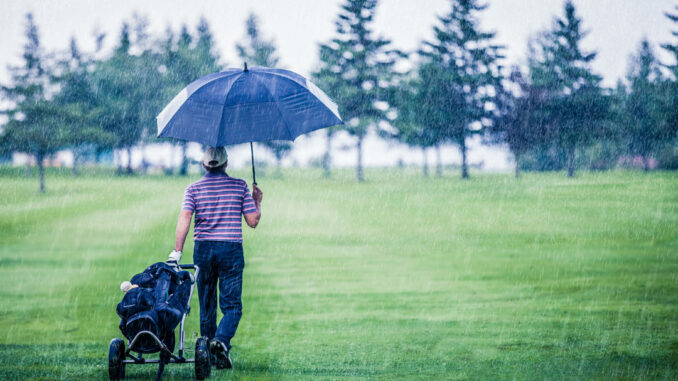
Procrastination is not my friend. That is why I need deadlines. Yet, despite these due dates, I sometimes extend them – asking my editors for forgiveness and a few days’ grace. Like now! After weeks ruminating about what to write, and as the calendar flipped to the next month on a holiday Monday – gazing at a calm Lake Huron on a humid early August morn – I finally focused. The words flowed like the water I witnessed rushing out of downspouts in the French Quarter during a recent family trip to New Orleans. The simile works, since this latest column is waxing on the weather.
There are few sports for which weather is such a determining factor to one’s success. Think of the PGA or LPGA tour and the luck involved with players’ early round tee times. Consider this: one player starts the day under rainy, windy conditions, struggling to make pars; then, by the afternoon, the clouds clear and the rains stop, making scoring easier for their fellow competitors.
Whether in golf or in life, there is one certainty: Mother Nature rules. Humans believe that they can control everything on this planet, but the weather is something that still eludes we homo sapiens and is ever more unpredictable. A decade ago, I wrote a feature for the member magazine of the Golf Course Superintendents Association of America that focused on weather as it related to a greenkeeper’s job. I asked dozens of superintendents what the biggest challenge was to their profession and, without hesitation, every single one answered Mother Nature.
Personally, I’m a fair-weather golfer. But I have played rounds in the pouring rain and enjoyed them. Your grips start to slip, the ball does not roll or travel as far and judging the speed of putts as the greens soak up the rain and slow them down becomes a guessing game.
Watching The British Open on TV earlier this summer – played at Royal Troon in Scotland – reinforced how weather adds another element to an already difficult game. The slogan, “Forged by Nature” was ubiquitous on the signs and sites around the famed links course. The layout/routing begins with holes that run adjacent to – and south along – the sea, so these opening holes are usually aided by the prevailing downwind conditions. This help from Mother Nature changes to a hindrance as the course turns inland and the winds become more unpredictable.
In the third round, gusts off the Firth of Clyde reached 30 mph and heavy rain left both players and fans soaked to the bone. “The wind kicked everyone’s ass, and it was a delight,” read a Golf Digest headline. Yes, for viewers, these challenging conditions added to the excitement. Watching the best players in the world struggle is fun because it shows us that these athletes are also human and even they can make high scores. The reality is, whether you’re a professional or an amateur, golf in windy weather is not ideal.
A golf scribe friend of mine loves these added challenges. He feels that this is why links golf is the game at its best since not only is one’s skill tested, but also one’s creativity, imagination and ability to analyze, assess and execute the right shot at the right time under adverse weather conditions.
Weather also affects the equipment and the playability of a golf course. For example, air temperature affects a ball’s flight. In the fall, cooler air increases the lift and the drag forces that act on your ball, resulting in a slightly higher and shorter trajectory. According to studies conducted by Titleist, a distance loss of 1.5 per cent can occur per a 20-degree Fahrenheit reduction in temperature. So, on a day when it’s 50 F as opposed to 70 F, a 200-yard shot could lose about three yards of distance. Not much but, when you tee it up this autumn before heading to your snowbird destination, do not be surprised or get too upset if your drives are not quite as long as they were mid-summer.
If you play a round following a significant rain event, when the golf course is still saturated, your drives will not roll as far as they do in dry conditions, which create firm and fast fairways. Don’t forget those dreaded ‘mud balls,’ when your shot lands and the ball gets coated in grime and debris. As if the game is not hard enough! The good news is that, unless you are playing in a tournament or with an opponent who is a stickler for the rules, you can clean these mud balls first before hitting them.
Gone With the Wind
When talk turns to the weather and the game of golf, there is no element more challenging than the wind. This is the X factor. Depending on which way – and how strong – these breezes blow changes the difficulty of a course from a walk in the park to a slog. If the winds are in your face, hitting a ball high is not ideal; Mother Nature’s messenger grabs your shot like a firm handshake and does not let go until it determines where it wants your ball to land. This is why, for some, links golf like The Open is so exciting because it demands creativity from players to hit low, bump-and-run shots rather than high-lofted wedges into greens to counteract these tricky conditions. When the wind is behind you, it’s an advantage, especially on drives but, no matter from which direction it blows, these breezes mess with club selection.
There is no set formula for determining how much to club up or club down. Most of us overestimate the wind’s speed when making these adjustments. A general rule of thumb is this: for tailwinds, add the rough mph wind speed to how much farther your ball might travel – i.e. 10 mph equals an extra 10 yards; for headwinds, take half the mph wind speed and that is the number of yards to subtract from the planned distance. So, if the winds are blowing at 20 mph, your shot will, on average, travel 10 yards fewer than under calm conditions.
Before hitting, take some extra time to look at the treetops and the flag in the distance to get a visual feel for the wind’s strength. Throwing some grass in the air is a simple trick I learned as a junior to get a rough feel for what the wind is doing. Crosswinds are usually the most difficult to judge and to assess your strategy since these swirling winds not only affect distance control, but also aim. I’m sure that, like me, you’ve misjudged many shots into these wild and unpredictable winds thinking that you hit your ball straight at the flag, only to have the wind send it flying sideways and many yards left or right of your intended target.
Whether or not you enjoy golfing in windy conditions, hopefully I’ve given you some food for thought, along with some helpful tips regarding how to deal with Mother Nature – on your terms – the next time you play.
